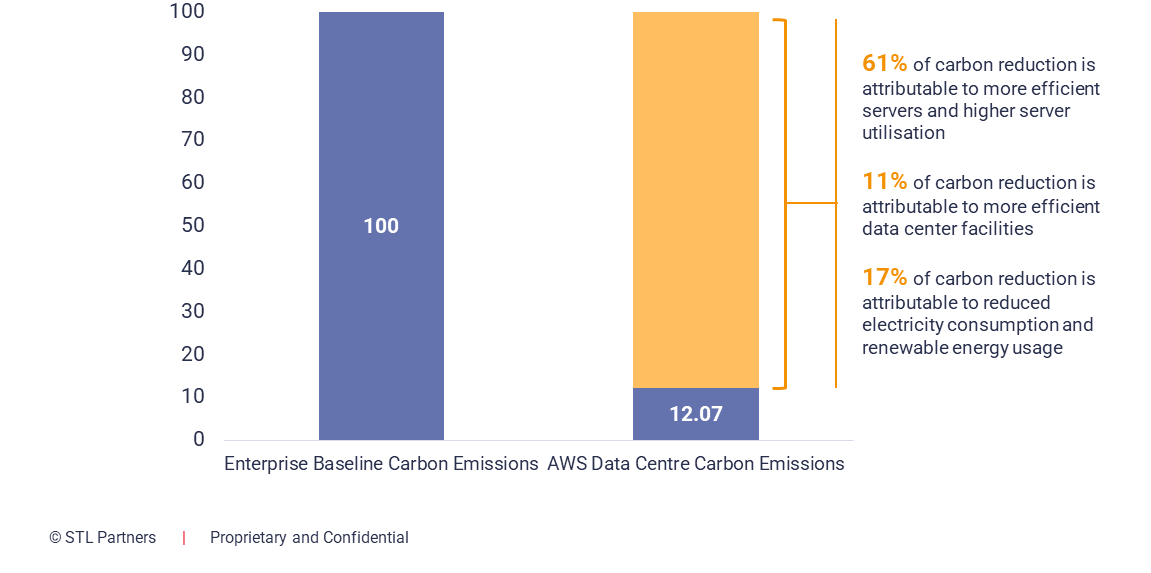
Data Centre Sustainability: How Telecom Operators are Driving Change
Data Centre Sustainability is emerging as a critical priority in a world where distributed networks are making inefficient data centres untenable. Telecom operators and their vendors are optimizing operations and spearheading sustainability initiatives that benefit all ecosystem stakeholders and the planet. This article examines the core elements of data centres contributing to emissions and highlights innovative efforts to reduce their impact.
Developing sustainable data centres
Telecoms operators are always looking to build out and scale their networks in a flexible manner. In attempts to do this, they have virtualised their networks – transitioned their previously appliance-based network functions to virtual functions, running on generic hardware. In many cases, this hardware is housed in datacentres, which are either dedicated to a given operator or are a shared facility.
These shared locations, crucial to data centre sustainability, are owned by large hyperscale cloud players (e.g. AWS, Microsoft) or data centre providers, offering carrier-neutral facilities. Operators, application providers and their end customers want to have quick and flexible access to resources and applications on-demand. To deliver increased availability, reduce network latency, meet customer expectations and stay ahead of their competitors, operators have distributed their network functions as close to their required locations as possible. Application providers have aimed to do the same with their software to enhance performance for the end user.
Demand for data centres is booming
As a result of all this demand, the need for data centres has exploded in recent years. The number of hyperscale data centres has more than doubled since 2015. This upward trend is due to continue, with the value of the global data centre market due to grow at a CAGR of 10.5%1. All of this growth is exciting for colocation providers, like Equinix, as well as for hyperscalers, operators and their end customers.
However, this growth comes at a price to the environment. These facilities and the servers housed within required a huge amount of power and therefore produce a significant carbon footprint. So, what are the drivers for this power consumption? What are data centre providers and users doing to tackle the challenge of balancing performance and sustainability?
Data centre sustainability metrics: Levers to reduce environmental impact
| Data Centre Sustainability Metrics | Key Points |
|---|---|
| Source of Power | Transitioning to renewable energy sources is critical, despite challenges in areas with limited access to renewables. |
| Cooling | Switching to efficient cooling methods, such as liquid cooling, can reduce Power Usage Effectiveness (PUE) and cooling costs. |
| Server Architectures | Efficient physical and logical server architecture can reduce power consumption and prepare for future expansion. |
There are three areas of consideration that data centre providers and direct consumers should reflect on when considering how to minimise the environmental impact that these facilities have:
- Source of power – given that datacentres consume considerable amounts of energy (globally data centres in 2021 consumed over 180 terawatt hours2, enough energy to power Ireland for over 6.5 years3) and due consideration should be given to the provenance of this energy. While some geographies benefit from better access to renewable energy, most locations have a large proportion of their energy sourced from non-renewable sources, such as oil, coal and natural gas. There are a handful of players, such as Facebook, Microsoft and Google that have committed to go 100% renewable. While commitments are a step in the right direction, there is a long way to go before a wholesale transition to use of only renewable energy is made. Transition in markets where access to renewables is scarce will be even more difficult.
- Cooling – each data centre server emits heat as they work to process data. Each of these servers is likely surrounded by hundreds, or thousands, of other servers also generating heat. To avoid faults through overheating, these servers need to be continuously cooled. There are two primary means of cooling servers, air and liquid. Air cooling, performed by large fans and ventilation shafts, has been the predominant cooling method in traditional data centres. While air cooling is effective, it is far less efficient than liquid cooling. Air cooling spreads some residual heat to other parts of the equipment or wider room. Air cooling is also far less space efficient. Liquid cooling, on the other hand, is compact, and far more effective at carrying heat away from source. Liquid cooling solutions can reduce PUE (Power Usage Effectiveness), as compared to an air-cooled solution by over 20%4. In both air and liquid cooled data centres, facilities based in colder climates can benefit from natural ‘free’ cooling to improve their PUE and reduce cooling costs.
- Server Architectures – the physical and logical architecture of servers is critical in ensuring the efficient running of a data centre. This encompasses energy efficiency too. When data centre servers are too close together and are physically or logically linked in an inefficient way, this drives the need to consume more power. Particular care should be taken when designing the data centre layout, physical and logical, in considering future mode of operation. If the facility expands, providers need to understand how existing and new servers will link together.
Data centre sustainability innovators: Driving a green agenda
In the sphere of data centre sustainability, there are innovators in the market who are not only looking to reduce emissions, but are also designing their facilities to be sustainable from the ground up. This means minimising emissions from the inception of their locations, and in some cases allowing other businesses to benefit through re-purposing the heat generated by data centre operation.
Data Centre Sustainability Innovators
| Company | Sustainability Practices |
|---|---|
| Green Mountain | Founded in 2010, uses 100% renewable energy, primarily hydro. Utilizes local cool climate for cooling the facilities. |
| Echelon | Collaborates with Biocore to use biogas for datacentres. Repurposes generated heat to dry by-products for local farm fertilizers. |
| Microsoft | Working on Project Silica to store data in quartz glass, which reduces space and climate control requirements. |
| AWS | Uses energy-efficient servers and higher server utilization. Integrated small battery packs and custom power supplies to reduce energy conversion loss by ~35%. |
Green Mountain – Green Mountain is a great example of a data centre provider with sustainable principles embedded in its practices. Founded in 2010, the company uses 100% renewable, primarily hydro, energy. Based in the Nordics, they use the cooler local climate to their advantage to help cool their facilities.
Echelon – as an established data centre provider, Echelon has reflected on how to reduce their environmental impact through partnerships. In Ireland, they have collaborated with Biocore, a biogas producer, to supply their datacentres with sustainable energy. The heat generated from the facility is used to dry the by-products from the energy production to create fertiliser for local farms for their crops.
Microsoft – Microsoft is working on an innovation project, Project Silica. The initiative is designed to reimagine the way that data is stored. The solution being developed looks to store data in quartz glass at high density. The space required to do so, as compared to traditional storage methods, is far lower. Moreover, the quartz glass does not need constant climate control, in both temperature and moisture terms.
AWS – A study conducted by 451 Research showed that AWS’s data centre infrastructure is 3.6 times more energy efficient than the median US enterprise data centre. This is due to more energy efficient servers, and higher server utilisation. AWS has removed the central uninterrupted power supply from its data centre design and integrated small battery packs and custom power supplies to its racks to reduce energy conversion loss by ~35%.
Carbon efficiency of AWS infrastructure compared to surveyed US enterprises

Towards net-zero data centres
As more data centres are built, the processing and storage burden on them increases. Companies across the data centre value chain must play a role in reducing the environmental damage dealt. While individual companies can make changes, partnership within the telecoms ecosystem and beyond is vital to make material progress.
STL Partners interviews GECCO: Innovating with edge form factors
Edge computing continues to gain traction. While it is not yet clear whether edge computing will be more sustainable than cloud data centres environments, a number of vendors have already begun to explore a range of options to minimise their carbon footprint. STL Partners sat down with GECCO, an edge server manufacturer, to understand how they are addressing this challenge through exploring innovative form factors.
How can telcos collaborate to avoid a climate disaster?
Telcos may be underestimating the importance of collaboration when it comes to achieving their sustainability targets.
Towards a platinum standard within scope 3 emission calculations
As scope 3 emissions continue to pose the most significant barrier to telcos’ net-zero targets, STL explores the ways in which the industry can address this challenge.




